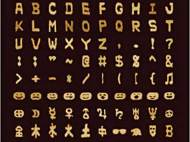SSTs – self-assembling synthetic DNA “building blocks”
 In an emerging field of science known as DNA nanotechnology, DNA is being explored for use as a material that can be used to build small and programmable structures. Researchers at the Wyss Institute have used short synthetic strands of DNA to developed interlocking DNA “building blocks” able to form complex nanostructures. Named single-stranded tiles (SSTs), the blocks can be programmed to assemble themselves into precisely designed shapes.
In an emerging field of science known as DNA nanotechnology, DNA is being explored for use as a material that can be used to build small and programmable structures. Researchers at the Wyss Institute have used short synthetic strands of DNA to developed interlocking DNA “building blocks” able to form complex nanostructures. Named single-stranded tiles (SSTs), the blocks can be programmed to assemble themselves into precisely designed shapes.
Unlike DNA origami method which uses a single long biological strand of DNA, which acts as a backbone along which smaller strands bind to its many different segments, to create shapes. Led by Wyss core faculty member Peng Yin, Ph.D., who is also an Assistant Professor of Systems Biology at Harvard Medical School, Wyss Institute researchers developed an alternative building method which uses short strands of DNA.
Each SST consists of a 42-base strand of DNA S folded into a 3nm-by-7nm tile which acts as a pixel. Since SSTs are composed entirely of concatenated sticky ends, they are able to connect to four surrounding neighbors. SSTs can interlock with another tile if it has a complementary sequence of DNA. If there are no complementary matches, the blocks do not connect. This allows the tiles to connect among themselves in specific, predetermined shapes through a series of interlocking local connections.
In demonstrating the method, the researchers created just over one hundred different designs, including emoticons, Chinese characters, numbers, and fonts, using hundreds of tiles for a single structure of 100 nanometers in size. Further development of the technology could enable the creation of wide variety of new nanoscale devices.
As synthetically based materials, the SSTs could have some important applications in medicine. SSTs could organize themselves into drug-delivery machines that maintain their structural integrity until they reach the cells marked for treatment. Another benefit in medical application is their synthetic nature which enables SSTs to be tailored in a way that makes them highly biocompatible.
“Use of DNA nanotechnology to create programmable nanodevices is an important focus at the Wyss Institute, because we believe so strongly in its potential to produce a paradigm-shifting approach to development of new diagnostics and therapeutics”, said Wyss Founding Director, Donald Ingber, M.D., Ph.D.
For more information, read the paper published in the online issue of Nature: “Complex shapes self-assembled from single-stranded DNA tiles”.









Leave your response!